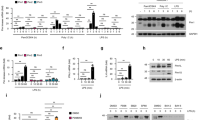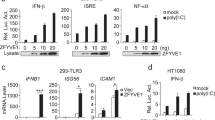Abstract
The transcription factors interferon regulatory factor 3 (IRF3) and NF-κB are required for the expression of many genes involved in the innate immune response. Viral infection, or the binding of double-stranded RNA to Toll-like receptor 3, results in the coordinate activation of IRF3 and NF-κB. Activation of IRF3 requires signal-dependent phosphorylation, but little is known about the signaling pathway or kinases involved. Here we report that the noncanonical IκB kinase homologs, IκB kinase-ε (IKKε) and TANK-binding kinase-1 (TBK1), which were previously implicated in NF-κB activation, are also essential components of the IRF3 signaling pathway. Thus, IKKε and TBK1 have a pivotal role in coordinating the activation of IRF3 and NF-κB in the innate immune response.
This is a preview of subscription content, access via your institution
Access options
Subscribe to this journal
Receive 12 print issues and online access
$209.00 per year
only $17.42 per issue
Buy this article
- Purchase on Springer Link
- Instant access to full article PDF
Prices may be subject to local taxes which are calculated during checkout






Similar content being viewed by others
References
Hiscott, J. et al. Triggering the interferon response: the role of IRF-3 transcription factor. J. Interferon Cytokine Res. 19, 1–13 (1999).
Genin, P., Algarte, M., Roof, P., Lin, R. & Hiscott, J. Regulation of RANTES chemokine gene expression requires cooperativity between NF-κB and IFN-regulatory factor transcription factors. J. Immunol. 164, 5352–5361 (2000).
Barnes, B., Lubyova, B. & Pitha, P.M. On the role of IRF in host defense. J. Interferon Cytokine Res. 22, 59–71 (2002).
Iwamura, T. et al. Induction of IRF-3/-7 kinase and NF-κB in response to double-stranded RNA and virus infection: common and unique pathways. Genes Cells 6, 375–388 (2001).
Yoneyama, M., Suhara, W. & Fujita, T. Control of IRF-3 activation by phosphorylation. J. Interferon Cytokine Res. 22, 73–76 (2002).
Servant, M.J. et al. Identification of distinct signaling pathways leading to the phosphorylation of interferon regulatory factor 3. J. Biol. Chem. 276, 355–363 (2001).
Servant, M.J., Grandvaux, N. & Hiscott, J. Multiple signaling pathways leading to the activation of interferon regulatory factor 3. Biochem. Pharmacol. 64, 985–992 (2002).
tenOever, B.R., Servant, M.J., Grandvaux, N., Lin, R. & Hiscott, J. Recognition of the measles virus nucleocapsid as a mechanism of IRF-3 activation. J. Virol. 76, 3659–3669 (2002).
Smith, E.J., Marie, I., Prakash, A., Garcia-Sastre, A. & Levy, D.E. IRF3 and IRF7 phosphorylation in virus-infected cells does not require double-stranded RNA-dependent protein kinase R or IκB kinase but is blocked by Vaccinia virus E3L protein. J. Biol. Chem. 276, 8951–8957 (2001).
Chu, W.M. et al. JNK2 and IKKβ are required for activating the innate response to viral infection. Immunity 11, 721–731 (1999).
Karin, M. & Ben-Neriah, Y. Phosphorylation meets ubiquitination: the control of NF-κB activity. Annu. Rev. Immunol. 18, 621–663 (2000).
Iordanov, M.S., Wong, J., Bell, J.C. & Magun, B.E. Activation of NF-κB by double-stranded RNA (dsRNA) in the absence of protein kinase R and RNase L demonstrates the existence of two separate dsRNA-triggered antiviral programs. Mol. Cell. Biol. 21, 61–72 (2001).
Fitzgerald, K.A. et al. Mal (MyD88-adapter-like) is required for Toll-like receptor-4 signal transduction. Nature 413, 78–83 (2001).
Alexopoulou, L., Holt, A.C., Medzhitov, R. & Flavell, R.A. Recognition of double-stranded RNA and activation of NF-κB by Toll-like receptor 3. Nature 413, 732–738 (2001).
Janssens, S. & Beyaert, R. A universal role for MyD88 in TLR/IL-1R–mediated signaling. Trends Biochem. Sci. 27, 474–482 (2002).
Cao, Z., Henzel, W.J. & Gao, X. IRAK: a kinase associated with the interleukin-1 receptor. Science 271, 1128–1131 (1996).
Oshiumi, H., Matsumoto, M., Funami, K., Akazawa, T. & Seya, T. TICAM-1, an adaptor molecule that participates in Toll-like receptor 3–mediated interferon-β induction. Nat. Immunol. 4, 161–167 (2003).
Kawai, T. et al. Lipopolysaccharide stimulates the MyD88-independent pathway and results in activation of IFN-regulatory factor 3 and the expression of a subset of lipopolysaccharide-inducible genes. J. Immunol. 167, 5887–5894 (2001).
Toshchakov, V. et al. TLR4, but not TLR2, mediates IFN-β-induced STAT1α/β-dependent gene expression in macrophages. Nat. Immunol. 3, 392–398 (2002).
Horng, T., Barton, G.M. & Medzhitov, R. TIRAP: an adapter molecule in the Toll signaling pathway. Nat. Immunol. 2, 835–841 (2001).
Yamamoto, M. et al. Essential role for TIRAP in activation of the signalling cascade shared by TLR2 and TLR4. Nature 420, 324–329 (2002).
Yamamoto, M. et al. Cutting edge: a novel Toll/IL-1 receptor domain-containing adapter that preferentially activates the IFN-β promoter in the Toll-like receptor signaling. J. Immunol. 169, 6668–6672 (2002).
Imler, J.L. & Hoffmann, J.A. Toll signaling: the TIReless quest for specificity. Nat. Immunol. 4, 105–106 (2003).
Ghosh, S. & Karin, M. Missing pieces in the NF-κB puzzle. Cell 109 (suppl.), S81–S96 (2002).
Peters, R.T., Liao, S.M. & Maniatis, T. IKKε is part of a novel PMA-inducible IκB kinase complex. Mol. Cell 5, 513–522 (2000).
Shimada, T. et al. IKK-i, a novel lipopolysaccharide-inducible kinase that is related to IκB kinases. Int. Immunol. 11, 1357–1362 (1999).
Tojima, Y. et al. NAK is an IκB kinase-activating kinase. Nature 404, 778–782 (2000).
Bonnard, M. et al. Deficiency of T2K leads to apoptotic liver degeneration and impaired NF-κB–dependent gene transcription. EMBO J. 19, 4976–4985 (2000).
Peters, R.T. & Maniatis, T. A new family of IKK-related kinases may function as IκB kinase kinases. Biochim. Biophys. Acta 1471, M57–M62 (2001).
Sakurai, H., Chiba, H., Miyoshi, H., Sugita, T. & Toriumi, W. IκB kinases phosphorylate NF-κB p65 subunit on serine 536 in the transactivation domain. J. Biol. Chem. 274, 30353–30356 (1999).
Maniatis, T. et al. Structure and function of the interferon-β enhanceosome. Cold Spring Harb. Symp. Quant. Biol. 63, 609–620 (1998).
Maniatis, T. Mechanisms of human β-interferon gene regulation. Harvey Lect. 82, 71–104 (1986).
Wathelet, M.G. et al. Virus infection induces the assembly of coordinately activated transcription factors on the IFN-β enhancer in vivo. Mol. Cell 1, 507–518 (1998).
Yoneyama, M. et al. Direct triggering of the type I interferon system by virus infection: activation of a transcription factor complex containing IRF-3 and CBP/p300. EMBO J. 17, 1087–1095 (1998).
Lin, R., Heylbroeck, C., Pitha, P.M. & Hiscott, J. Virus-dependent phosphorylation of the IRF-3 transcription factor regulates nuclear translocation, transactivation potential, and proteasome-mediated degradation. Mol. Cell. Biol. 18, 2986–2996 (1998).
Matsumoto, M., Kikkawa, S., Kohase, M., Miyake, K. & Seya, T. Establishment of a monoclonal antibody against human Toll-like receptor 3 that blocks double-stranded RNA-mediated signaling. Biochem. Biophys. Res. Commun. 293, 1364–1369 (2002).
Muzio, M., Ni, J., Feng, P. & Dixit, V.M. IRAK (Pelle) family member IRAK-2 and MyD88 as proximal mediators of IL-1 signaling. Science 278, 1612–1615 (1997).
Janeway, C.A. Jr. & Medzhitov, R. Innate immune recognition. Annu. Rev. Immunol. 20, 197–216 (2002).
Pomerantz, J.L. & Baltimore, D. NFκ activation by a signaling complex containing TRAF2, TANK and TBK1, a novel IKK-related kinase. EMBO J. 18, 6694–6704 (1999).
Servant, M.J. et al. Identification of the minimal phosphoacceptor site required for in vivo activation of interferon regulatory factor 3 in response to virus and double- stranded RNA. J. Biol. Chem. 278, 9441–9447 (2003).
Chariot, A. et al. Association of the adaptor TANK with the IκB kinase (IKK) regulator NEMO connects IKK complexes with IKKε and TBK1 kinases. J. Biol. Chem. 277, 37029–37036 (2002).
Lee, F.S., Hagler, J., Chen, Z.J. & Maniatis, T. Activation of the IκBα kinase complex by MEKK1, a kinase of the JNK pathway. Cell 88, 213–222 (1997).
Yang, H. et al. Transcriptional activity of interferon regulatory factor (IRF)-3 depends on multiple protein-protein interactions. Eur. J. Biochem. 269, 6142–6151 (2002).
Latz, E. et al. Lipopolysaccharide rapidly traffics to and from the Golgi apparatus with the Toll-like receptor 4–MD-2–CD14 complex in a process that is distinct from the initiation of signal transduction. J. Biol. Chem. 277, 47834–47843 (2002).
Brummelkamp, T.R., Bernards, R. & Agami, R. A system for stable expression of short interfering RNAs in mammalian cells. Science 296, 550–553 (2002).
Acknowledgements
We thank C. Lin, W. Niu, N. Silverman, J. Rosains, I. Udalova, J. Tian, L-A. Feeney, K. Nagashima, M. Dorsch, B. Monks and B. Barnes for technical support and discussions. This work was supported by the Wellcome Trust (K.A.F.), the Cancer Research Institute (S.M.M.) and grants R01 GM54060 (K.A.F., D.T.G.) and R01 AI20642 (S.M.M., T.M.) from the US National Institutes of Health.
Author information
Authors and Affiliations
Corresponding authors
Ethics declarations
Competing interests
K.L.F., A.J.C. and S.-M.L. are employees of Millennium Pharmaceuticals, Inc. of Cambridge, Massachusetts, USA. K.A.F., S.M.M., D.C.R., E.L., D.T.G. and T.M. have no competing financial interests.
Rights and permissions
About this article
Cite this article
Fitzgerald, K., McWhirter, S., Faia, K. et al. IKKε and TBK1 are essential components of the IRF3 signaling pathway. Nat Immunol 4, 491–496 (2003). https://doi.org/10.1038/ni921
Received:
Accepted:
Published:
Issue Date:
DOI: https://doi.org/10.1038/ni921
This article is cited by
-
Hepatocyte GPCR signaling regulates IRF3 to control hepatic stellate cell transdifferentiation
Cell Communication and Signaling (2024)
-
Innate immune sensing of lysosomal dysfunction drives multiple lysosomal storage disorders
Nature Cell Biology (2024)
-
Cholesterol-binding motifs in STING that control endoplasmic reticulum retention mediate anti-tumoral activity of cholesterol-lowering compounds
Nature Communications (2024)
-
IKKε and TBK1 prevent RIPK1 dependent and independent inflammation
Nature Communications (2024)
-
LUBAC is required for RIG-I sensing of RNA viruses
Cell Death & Differentiation (2024)



